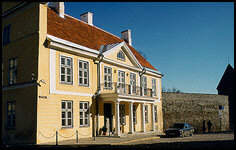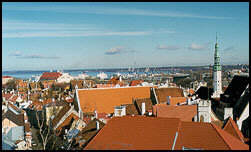 Geography Geography |

 Location Location |
Estonia lies on the eastern shores of the Baltic Sea, just about 80 km (48 miles) south of Finland. Sweden, Estonia's western neighbor is about 300 km (180 miles) across the Baltic Sea. Russia is to the east, with St. Petersburg just across the north-eastern border. Latvia is Estonia's southern neighbor.
Estonia is a rather small country, actually small enough to be covered by a day's driving in any direction. Its territory is not very large, but it is still slightly bigger than Denmark, Netherlands, Belgium or Switzerland. The maximum distance from east to west is about 350 km (210 miles) and from north to south about 250 km (150 miles).
Estonia is generally low and flat country with only slight elevation, which rarely exceed 100 m above sea level. The highest point, Suur Munamägi, reaches 318 m above sea level. Still, for a small territory like Estonia, the landscapes are of a surprisingly varied and original character.
North Estonia consists for the most part of limestone plateaus ending abruptly at the steep edge of the North-Estonian Glint. South Estonia is known for its great variety of landscape - rounded hills, abundant tiny lakes and numerous picturesque valleys. West Estonia has the lowest elevations and is the most maritime part of the country.
The coastline of the Baltic Sea in Estonia is characterized by numerous bays, straits and islets. Estonia has over 1,500 islands, the largest being Saaremaa (2,922 sq km) and Hiiumaa (989 sq km).
Estonia is rich in inland water bodies. There are over 1,400 natural and man-made lakes. The largest lake, (3,555 sq km) Lake Peipsi, is the fourth largest lake in Europe. The deepest lake is Rõuge Suurjärv with a maximum depth of 38 m. The longest river is the Pärnu which for 144 km through the Southeast Estonian countryside.
About 40% of Estonia is forest, fens and bogs cover 22% of the territory.
 Border country Border country |
Of the three Baltic States, Estonia is the northernmost and the closest to being a border area. North and Central Europe's borders cross in Estonia as do those of East and Central Europe. Those borders are geographical, cultural, linguistic, historic and political.
Estonia, along with Finland, is the westernmost country in Northern Europe where Finno-Ugric languages are spoken. Estonia was, however, also where the easternmost German Hanseatic cities with a German speaking basic population were located. On the other hand, Estonia is one of the westernmost European countries where a Russian Orthodox community has existed since the 17th century. The Estonians are, however, the only people of whom a substantial part (over 10 per cent) converted to the Orthodox faith in mid-19th century in the hope of gaining economic benefits thereby.
This reflects not only the alienation of an
oppressed nation from the religion of its masters,
but also the geopolitical border position of Estonia
- the fact that it was located in an East-West transit
area in Europe. East in this case is defined as
Orthodox Russia, and West in interpreted as Catholic-Protestant
Central and Western Europe. At the beginning of
the 13th century, an eastward expansion
by the West occurred, in the course of which the
crusaders conquered Constantinople (1204) in the
south and part of the present day Baltic states
and Northwest Europe, until Russia became strong
and turned into a major European power. Before that,
Estonia's eastern border had been also the eastern
border for the West and Estonia had been politically
as well as culturally, in the West. |

When Russia conquered Estonia during the Nordic Was (1700-21), initially it only meant a westward shifting of the East's political border. Culturally, no major change occurred: German urbanites and nobility retained their preeminent position, as did German language and culture. Estonia's eastern border remained the border between two cultural regions. Not until the end of the following century did the Czarist regime attempt to change this. In the 1880s, a Russification campaign was launched to break the power of local Germans. Among other things, only Russian was allowed in schools and institutions.
The Czarist campaign did not succeed, although it did weaken German power and cultural monopoly in the Baltic countries. But it also gave Estonians an opportunity to free themselves from German power and influence, and to become a third force between two contending parties.
Cultural and political freedoms of Estonians had depended on the power struggles played out at the East-West border and how that border has shifted. Just as reduced German power helped Estonians achieve greater cultural independence, disintegration of the Russian empire helped them to achieve political independence. In both cases, Estonian leaders took advantage of indeterminate developments.
Soviet Union was on the side of World War II World Investment News Ltdrs and thus succeeded in shifting the East-West border farther west than ever before. Its borders came to include Estonia as well. The regime's aim was not merely to consolidate its political power in the conquered territories, but to thoroughly Russify them as well. It turned out differently. In spite of an official cultural policy and mass immigration of Russians, Estonians were repelled by these policies and developments rather than attracted to everything Russian and Soviet. Knowledge of Russian did not improve in Estonia. It declined, as did interest in Russian culture. Estonia's desire for freedom from the Soviet Union and reestablishment of relations with Europe was strong long before Gorbachev's perestroika.
The East-West border has moved again and Russia has lost a large part of the territories it had conquered, including Estonia. Becoming a member of the European Union, along with other East European countries, is probably the next important event in the history of Estonia. The accession negotiations started in 1998. Hereafter the future of Estonia will be more and more closely tied to the future of a united Europe.
 Distances in straight line from Tallinn Distances in straight line from Tallinn |
Helsinki 85 km (51 miles)
Riga 280 km (168 miles)
St. Petersburg 330 km (198 miles)
Stockholm 375 km (225 miles)
Vilnius 520 km (312 miles)
Oslo 790 km (474 miles)
Warsaw 820 km (492 miles)
Copenhagen 830 km (498 miles)
Moscow 860 km (516 miles)
Berlin 1040 km (624 miles) |

